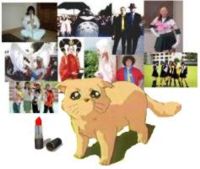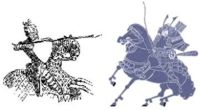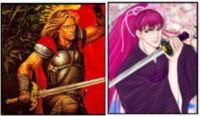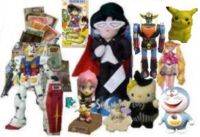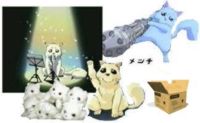The wonderful mental climate Japan has been blessed with in this area has produced the unparalelled convention of amateur comic books (doujinshi). A sort of fest is hold regularly to house all people whose imagination is to be shared, or so they think; amateur artists and storytellers sell their homemade stuff there. Ranging from Xeroxed pages to artpapered tomes, the unknown artists' produce is one hell lot of rainbowy works. Usually each doesn't make more than 200 to 5000 copies, so this is the same as inviting rarity. Some amateur comic books have now become collector's items and could fetch thousands of dollars at an online auction. Professional manga artists grow from exactly this spot, and many of them never leave it anyway -- the crowd that devour the amateur art is the best market-testers they could find before launching a new series.
Fan-subs, which means anime movies being snatched off the rightful owner, translated into other languages, and redistributed with the subtitle within, mostly for free or for a meagre sum of real cash, have built upon the already existing foundation to let anime acquire some robust vivacity. Anime video piracy is outlawed everywhere (even in Indonesia, its previously thriving business site, since July 2003), and as one who make a living out of something that has everything to do with copyrights, I cannot endorse the practice, yet we got to face it: with regards to anime, there has been no other way to feed the hungry fans because original DVD's and VCD's sold overseas by the Japanese only consist of a meaningless number of titles, and whatever doesn't sail beyond the Japanese seas in bulk is in Japanese. Despite the recent rise of number of people who enter courses, for real less than one in ten thousands knows this language, outside the country. My neighbor does, but he can't get far with knowing just 'baka' ('foolish') and 'arigato' ('thanks') -- the two precious words on his command don't even click together in one phrase. Anyway, here is the problem for anime and manga; if linguistic isolation is let to drag itself to forever, then they are significantly hopeless. The subject of language has been taken up in discussions about Japanimation, but banging the same old door of "but pictures are worth all the words in the world" isn't the right way to deal with it, even if it is just because it doesn't deal with it. Again, in this, it is mostly fans who understand where the clog is and try to do their own linguistic plumbing, no matter how haphazard it might look at times -- a well-meaning fan who did the subtitle of an anime I've seen even translated the English narration -- into something even more incoherent than the original. Yet, this sort of accident warms my heart. While a homepage I bumped into several nightmares ago put this notice board at its front porch (quoted faithfully): "For professionals only. There is no translation nor pictures." -- and it didn't lie, the whole site was like that. A nice, neat, awe-inspiring warehouse of Japanese-font-faced something, I can't tell you what, because I could only got the English and German warnings. Such an unwelcoming attitude couldn't get you anywhere. It is against the tide of times, it is against commonsense. Unless, of course, you are a Tokugawa in 18th-century. In terms of visualization, Northern and Japanese animation movies cannot be subjects of a comparative study because they are merely very different.
One of the most famous manga artists, one whose Captain Harlock series and its subsequent revamps are among my favorites, Matsumoto Leiji, didn't make Harlock for the reason that he could not draw Beauty and the Beast [click here to see Matsumoto's creations]; while one of the animators I respect the most, Nick Park, didn't create Wallace and Gromit only because he had no skill to generate Rurouni Kenshin. Just like William Shakespeare didn't write The Adventures of Huckleberry Finn, it is a matter of taste and style or, as artists usually say, the will of the brush.
In terms of visualization, the difference is easy enough to recognize. What is considered a beauty, what kind of men heroes are made of, what deeds are laudable and what punishment is reserved for the wrong kind of transgressors -- all thoughts and concepts around social ethics and philosophy are socialized to one generation to another. No matter how it keeps on changing, a culture would still retain its essence after thousands of years -- or else it would have perished on Wednesday night, September 11, 1 B.C.
Sense of perspective, human body drawing scale, commonest colors of things, etcetera, make visual artworks. If those are different, so would the net outcome be. Shapes of the swords, for instance; swordsmanship itself, notions of honor and courage, love and devotion, passionate enmity and the lust for vengeance -- all these typical ingredient of today's so-called 'entertainment' have always been different as well between Japan and the Northern Hemisphere, that the action comics and animation movies are also different.
And that is why, actually, manga and anime as this planet's treasure could give more.
Anyway, merchandising is one striking Japanese habit. Manga artist Tagawa Suihõ, for instance, has inspired manufacturers to sell this and that and even more of his Norakuro character, back in the 1930's of pre-war Japan. Today, all you have to do is just browse a little and there you would find everybody trying to appeal to your credit card again by fluttering all sorts of things emblazoned with your favorite anime or manga character. It is really an infernal age for the small-spenders to live in.
Back to the topic of manga; although the word 'manga' is capable of housing every sort of visualization, encompassing caricatures, comic strips and cartoons at once, the one it represents most staunchily is the comics, Japanese comics at that, while anime mostly denotes Japanese animation movies -- tailed by any other nation's product that is confessedly inspired by, unconsciously looking like, or consciously mimicking, the Japanese comics style. What is the 'Japanese style'? This is beyond my fan-like capacity to answer, especially not in less than one book. So, all I can say here and now is, see for yourself. Words will only do injustice to what your eyes could download in visual data. Live the atmospheric description of what makes Japanese drawings Japanese. Bon voyage.
Recommended anime to watch: Golden Boy (video, 1995, director Kitakubo Hiroyuki, produced by KSS) -- this is about the process of making an anime movie. Comic Party (series, 2001, director Sudo Norihiko, produced by OLM/KBS) -- about the culture of amateur comic bookmakers; by far one of the best faces of Japan.
CLICK HERE CLICK HERE CLICK HERE CLICK HERE CLICK HERE CLICK HERE CLICK HERE CLICK HERE CLICK HERE CLICK HERE CLICK
CLICK HERE CLICK HERE CLICK HERE CLICK HERE CLICK HERE CLICK HERE CLICK HERE CLICK HERE CLICK HERE CLICK HERE CLICK |
|||||||||||||||||||||||||||||||||||||||
|
| OUTBOUND LINKS |
Anime image galleries - Anime academy - Anime synopsis - Anime pop culture - Anime history in English - Anime history in Italian - Anime history in Russian - Japanese rare prints and drawings - History of Japanese samurai & the feudal system - Just one example of a fan site with personal review - Matsumoto Leiji database - Ragnarök - Takeuchi Naoko - Kurumada Masami - Gundam - CLAMP - Best Asian Movies - My Species of Japanese Actors - All & Everything about Japanese Culture |

